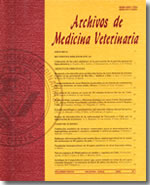Di- and triploid erythrocyte identification by multi-parameter image analysis: A new method for the quantification of triploidization rates in rainbow trout (Oncorhynchus mykiss)
Main Article Content
Abstract
Growing international competition is forcing salmon farmers to incorporate innovative techniques into the production process. The use of triploid, all-female breeding populations offers multiple advantages over diploid populations. Currently, an exact, simple, and non- hazardous method for the quantification of diploid- and triploid salmon erythrocytes does not exist. We present a method that combines a standard microscopic bright field technique (contrast staining with GIEMSA) with multi-parameter image analysis and termed it quantitative morphologic microscopy (QMM). We used flow cytometry (FC) as the reference method to determine the DNA content of di- and triplod erythrocytes from immature rainbow trout (Oncorhynchus mykiss). Additionally, we applied quantitative fluorescence microscopy (QFM), using the DNA stains 4',6-diamidino-2-phenylindole (DAPI), propidium iodide (PI), and acridine orange (AO). Our data show that QMM possess comparable or even superior discriminating capacities than FC or QFM. The developed method opens a perspective for the classification of microscopic objects with many possible applications.

